A Major Thoroughfare That Maintains Its Main Street Appeal

Atlantic Avenue in Brooklyn may not have the cool factor of Grand Street in trendy Williamsburg or the wide draw of DUMBO by the Brooklyn waterfront — but it’s only a matter of time.
What Atlantic Avenue does have is a concentration of unique, small, neighborly shops with sophisticated, often exotic fashion, home and food offerings — a practically unbroken stretch from near the Brooklyn Queens Expressway stretching east for seven blocks, from Henry to Nevins Streets.
More from WWD
Among the stores are the tiny Ella Crown Bakehouse, 149 Atlantic Avenue, popular for its rich chocolate chip cookies and free cups of coffee; the Hatchet Outdoor Supply Co., 77 Atlantic Avenue, for on-trend, brand-name activewear, gear and accessories for men; Page Sargisson, 347 Atlantic Avenue, for handcrafted fine jewelry made from recycled 18kt gold, rainbow sapphires and diamonds designed on site; Primary Essentials, 372 Atlantic Avenue, which has candles, quilts and other home products from local artisans, and the Jao Social Club apothecary, 357 Atlantic Avenue, which has a wide wholesale distribution.
There are also several Middle Eastern food and beverage establishments, like Damascus Bread and Pastry Shop, 195 Atlantic Avenue, selling pita and other traditional breads since 1930; Sahadi’s, the Middle Eastern food market which has been at 187 Atlantic Avenue for 73 years, and the Yemen Cafe and Restaurant, 176 Atlantic Avenue. They both have second Brooklyn locations.
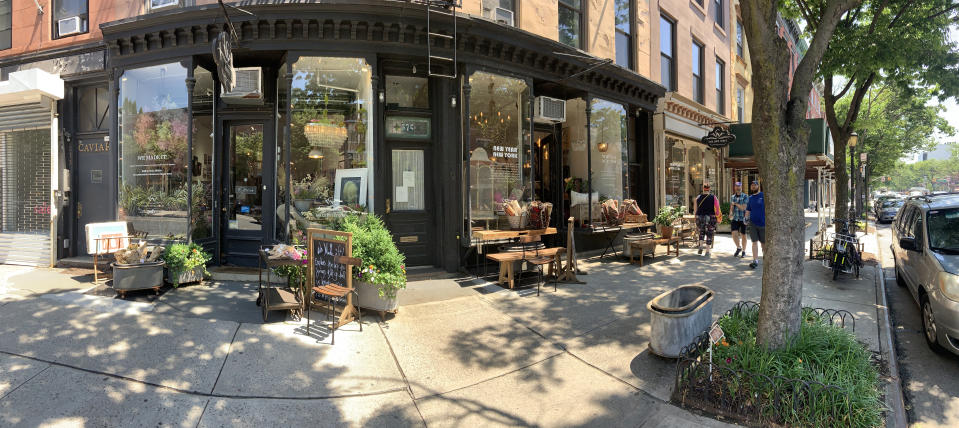
The block between Hoyt and Bond Streets has a mix of vintage, consignment and home furnishings shops, such as Horseman Antiques, 351 Atlantic Avenue, a reminder of years ago when the avenue was a different kind of destination.
“It was all antique shops when I first moved here,” said Marcia Patmos, a designer who owns M. Patmos at 380 Atlantic Avenue.
Those antique and dusty used furniture shops are mostly gone and have been replaced by contemporary fashion, home and interior design establishments, independently owned, such as the M. Patmos store. It sells a mix of contemporary, vintage and sustainable fashion, including cashmere cardigans, priced $425, and maxi dresses, priced $265, designed by Patmos. There’s also a range of products and prices from other brands that aren’t overly distributed, such as Coclico sandals and Nymane cotton dresses.
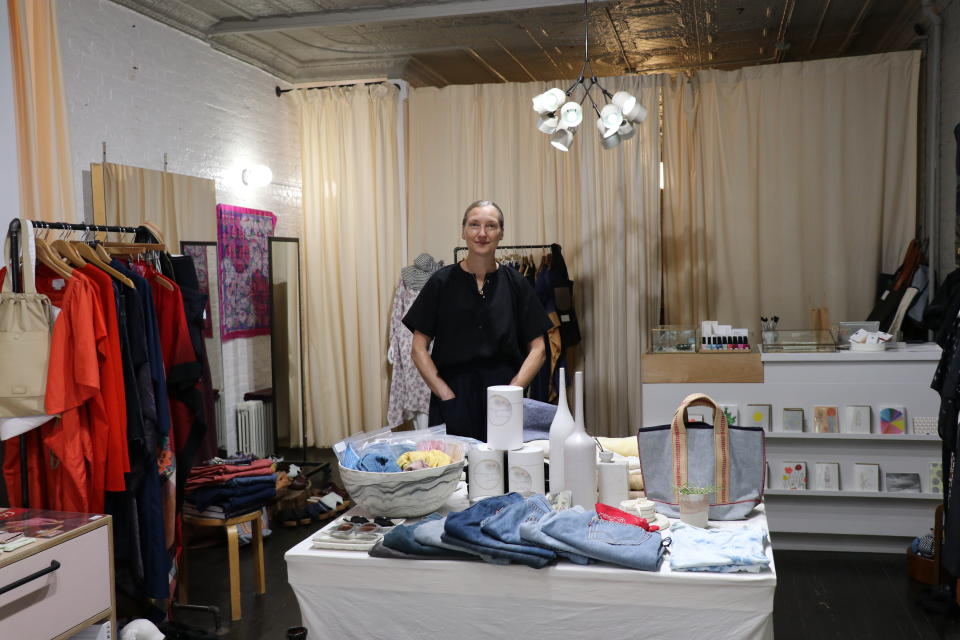
The transformation of that western section of Atlantic Avenue — which separates the Boerum Hill and Cobble Hill neighborhoods on the south side from Brooklyn Heights and downtown Brooklyn on the north side — is part of the borough’s gentrification and steady residential and commercial development over the last few decades. Heading east toward the Barclays Center and Atlantic Terminal, there’s a smattering of big-box retailers including Trader Joe’s, Marshalls, 7-Eleven and Michaels crafts, bringing more of a mass appeal to the area. The large Barneys New York site at 194 Atlantic Avenue, which has been closed since August 2019, remains vacant and could very well be taken over by another big box. There are rumors that Amazon is interested in Atlantic Avenue, possibly with an Amazon Go or even perhaps one of the new, small-format department stores it reportedly is considering launching.
In that part of Brooklyn, “There are two sides to Atlantic Avenue retailing,” observed Brandon Singer, founder and chief executive officer of Retail by Mona, a real estate leasing and advisory firm. “That whole corridor by the Barclays Center has stayed strong. There is deal velocity, and with the emergence of the Brooklyn Nets as one of the best teams in the league, it’s really become a major hotbed in the last couple of years. Sephora opened across in Atlantic Terminal in 2019. Dave & Busters signed a lease to move in. Snipes apparel opened on Flatbush Avenue across from Barclays, and Chick-fil-A and Shake Shack have two of their best stores there. A lot of national chains are in the market looking. Athletic companies are all looking there. But when you get closer to the East River, the retail culture changes. It’s local mom-and-pop stores totally.”
Singer said the retail rents by Barclays are in the low $200-a-square-foot range, and that as one proceeds west along Atlantic Avenue, the rents drop to around $75 to $100 a square foot.
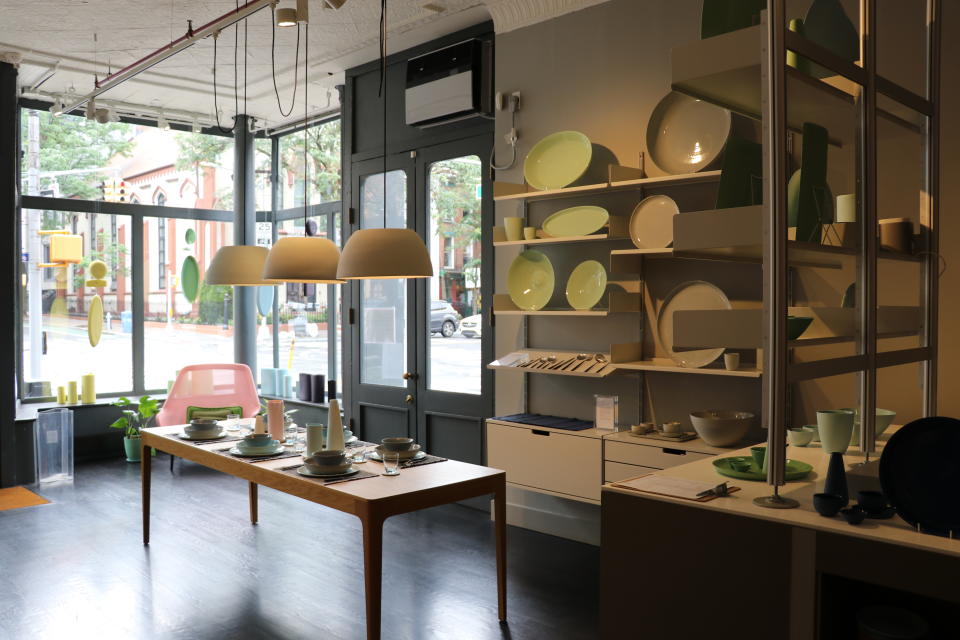
Daniel Hodges, CEO and founder of Retail Store Tours, has just expanded his program to Brooklyn, exploring new and different concepts on Atlantic Avenue, Industry City, Williamsburg and DUMBO.
The merchants on Atlantic Avenue he highlights share several characteristics. “The first is the human touch. The staffs are trained to listen, to be empathetic and customer-focused. The second thing is store design — the lighting, the layout, the architecture — each tells a brand story.
“Every one of the owners has an engaging entrepreneurial story. Consignment Brooklyn was started 18 years ago by the owner emptying out her closet,” said Hodges. And what’s interesting, he added, is that several of the owners network to share marketing techniques or safety and health concerns. “Most of their business is supported through people who live in the area. The revenue on Atlantic isn’t subject to tourism. It’s partially driven by the local market, but there are also many interior designers who come through for ideas, to design other people’s homes or office buildings.”
Eva Dayton opened Consignment Brooklyn in 1999. She formerly was a visual coordinator at Giorgio Armani and Canali, and her store, which sells secondhand clothing from such brands as Celine, Prada, Levi’s and Isabel Marant, reflects that. “Even though I’m selling secondhand clothing, I wanted my store to be clean and modern. More and more people are coming to Brooklyn to shop and spend hours here,” on Atlantic Avenue. “They want to make sure they get their fill. They don’t want to be missing anything.”

“There’s a critical mass here. We’ve got enough good shops here to make a trip worthwhile. These are one-of-a-kind stores you don’t see coming and going. They’re highly curated by professionals, powerful women with 10, 20 years experience,” said Mary Jo Pile, owner of the 10-year-old Collier West, which operates three contiguous stores. There’s the main Collier West, at 377a Atlantic Avennue, selling vintage and antique furniture, original art, gifts, chandeliers, bath and body products, candles and jewelry; the Collier West Rugery at 377 Atlantic Avenue, and the Collier West Annex, 375 Atlantic Avenue, which is a rotating art gallery for paintings, prints, photography and etchings.
“Business in July was actually pretty good. August so far is OK. We started to get domestic travelers. People are definitely finding us,” said Pile, a former executive vice president at Express and Aeropostale. “We are getting more Manhattanites, and a lot of locals are figuring out the neighborhood who were so used to working in Manhattan and wandering around there to shop. We also get a lot of set designers and interior decorators and we get a lot of Japanese tourists. They’re intrepid.
“The neighborhood has definitely evolved. So many new apartments have been built in the area and they’re not inexpensive. We don’t just cater to one group, and I wouldn’t say it’s the one-percenters. It’s probably the 10-percenters.
“I wouldn’t have made it through this pandemic had my landlords not been so understanding, I have two landlords,” said Pile. “When I shut down, I gave 50 percent rent. As business ramped up, I gave a higher percent and then we renegotiated. It’s a completely different tenant-landlord relationship than you have with a mall. There are good and bad things about it, but most of it is better. There is a human being you can talk to, and most understand what people can afford to pay. I have to pay salaries, buy goods, pay rent, utilities. The pandemic was a reset. I am not back up to what I was paying before, because we renegotiated and will revisit it on Jan. 1. We didn’t take off a lot, maybe 10 or 15 percent.”
Pile also said that there’s an “ad hoc” group of female shopkeepers between Hoyt and Bond Streets. “We share texts. Pop in and out for coffee, and if someone has a question, about this app or something, it’s kind of like you have your own support group. The people are very generous with sharing which makes the block better. You don’t get that in commercial retail.”
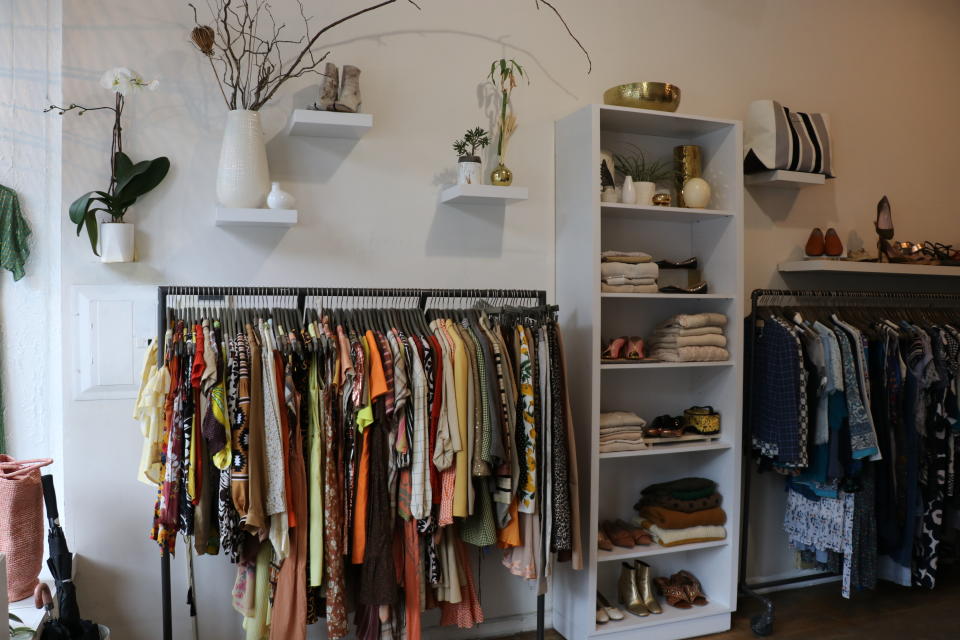
“There’s been a significant migration from SoHo to Brooklyn. A lot of creative professionals now live in Brooklyn and that is really my customer base,” said Michele Varian of the shop at 400 Atlantic Avenue that bears her name. Her store sells pillows, lighting, baskets, wallpaper, furniture, tableware, jewelry, art, ceramics and gifts. “I design and manufacture a lot of the lighting, the pillows, wallpaper and some furniture.” Lighting is created downstairs in the shop, which employs a full-time fabricator for the lighting and a seamstress for the pillows.
“I really do believe successful retail is the kind of retail that’s integrated into people’s lifestyles,” Varian said. “We are part of the residential community which is totally how it used to be in SoHo. I live in SoHo. It’s become tourist-driven. We have been robbed of our streets during the day, but it’s a beautiful neighborhood when it’s not overrun with people.”
Varian moved her store from SoHo right before the pandemic, in January 2020. “I can not overstate how important that was. I had the shop in SoHo for 20 years. It was as though my landlord was my boss. I am paying 30 percent of what I was paying in SoHo. If I was still in SoHo I would be out of business.”
Asked what she thinks makes Atlantic Avenue distinctive, Varian said, “The historic storefronts are very striking but within those storefronts you’ve got the owners on site,” bringing their personal taste and preferences to the merchandising and decor. “It’s a more traditional retail experience that hearkens back to olden days,” said Varian. “You see people you know. You have conversations and relationships with the store staff. There are like-minded people and so many of my customers and many of the people on Atlantic Avenue are looking for things they can’t find somewhere else. It’s a discerning clientele craving things they haven’t seen online.”
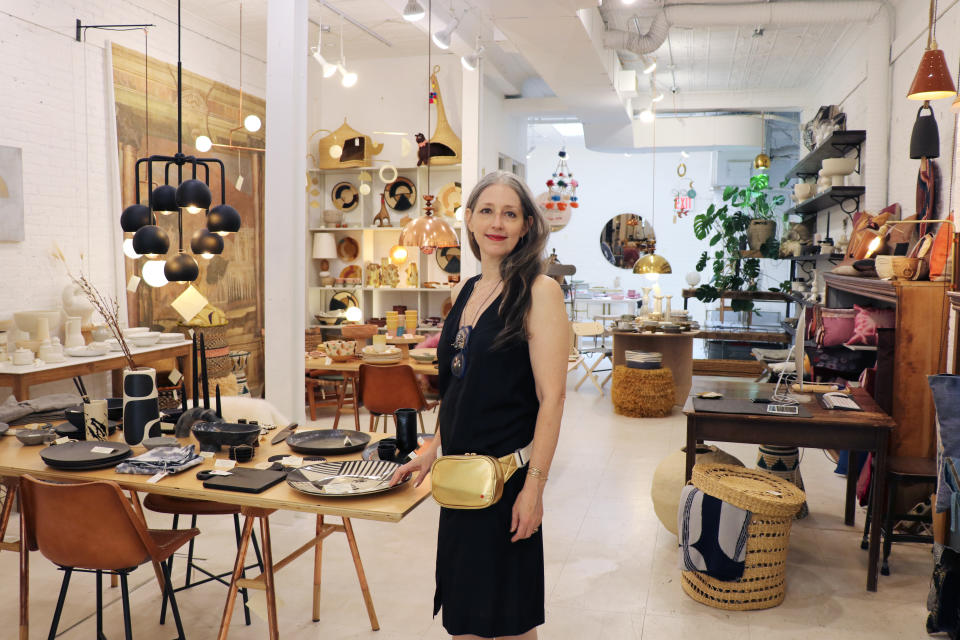
Sign up for WWD's Newsletter. For the latest news, follow us on Twitter, Facebook, and Instagram.

